July 1
| 1905 | OPRI becomes OPR under the Agriculture Appropriation Act of March 3, 1905. For the first time, the Agency is permanent, with an annual budget of $50,000. Director Martin Dodge had worked hard to achieve these goals. However, as a lawyer, he was prohibited by the new law from heading OPR. The Director must "be a scientist and have charge of all scientific and technical work." Logan Page becomes Director at a salary of $2,500. His staff includes a Chief of Records (M. O. Eldridge), a Chief Clerk (J. E. Pennybacker, Jr.), a Chief of the Division of Tests (Dr. A. S. Cushman) and a Chief of Construction (A. N. Johnson), an Instrument Maker, and six clerks.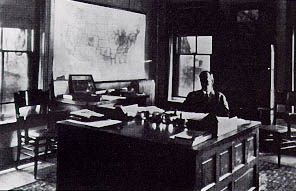
|
| 1915 | OPR becomes the Office of Public Roads and Rural Engineering. |
| 1918 | OPRRE becomes the Bureau of Public Roads. |
| 1924 | BPR discontinues the practice of testing samples of road materials for any U.S. citizen. Samples will be tested only if submitted by or at the request of government officials and then only if the request is accompanied by a statement that the sampling was done by a disinterested party. The statement should be made on BPR Form T-206. |
| 1939 | BRP becomes the Public Roads Administration and is shifted from the Department of Agriculture to the Federal Works Agency. |
| 1942 | In Panama, after working day and night, PRA completes the 52-mile Chorrera-Rio Hato Road to an important military airfield at Rio Hato. About half the mileage had been completed in cooperation with Panama when the U.S. entered World War II and the U.S. Army demanded that work be completed by June. PRA completed the road without cost to Panama. |
| 1949 | PRA becomes the Bureau of Public Roads, briefly part of the General Services Administration before moving to the Department of Commerce on August 20. |
| 1977 | In Washington, DC, the Metro subway opens its second line, this one serving the L'Enfant Plaza Station at the USDOT Headquarters. Over the years, Interstate substitution funds totalling more than $2 billion were transferred to Metro transit projects. The opening ceremony in the USDOT Building plaza features Executive Director Lester Lamm, Deputy Administrator Charles F. Bingham of UMTA, and Theodore Lutz, General Manager of Metro. |
July 2
| 1900 | 1900 ORI's initial involvement in the international road community occurs at the First International Good Roads Congress at Port Huron, MI, launched by Michigan's Horatio S. Earle with Director Martin Dodge's enthusiastic support. Dodge arrives today and works with Road Expert E. G. Harrison, who had begun work on an object lesson road on July 1. In addition to supervising this work, Dodge presides over the convention on July 3 and 4. |
| 1992 | FHWA joins with the North Carolina Department of Transportation in a pilot partnership agreement with North Carolina A&T University, the first of five such partnerships with Historically Black Colleges and Universities. The objective is to increase the opportunities for the college and its students with FHWA and State DOTs. |
July 3
| 1906 | Under a plan signed today by Secretary of Agriculture James Wilson, a locality desiring a rural mail route can petition OPR for an engineer to examine the road and recommend any needed improvements (the joint plan is approved by the Postmaster General on July 10). |
| 1938 | Ceremonies in Berthoud Pass, CO, mark completion of the last paved segment of U.S. 40. BPR's Clyde Learned had largely determined the location and was involved throughout construction, prompting journalist H. B. Rose to say, "Learned has built himself in every foot of that superb surface and in every yard of the structure."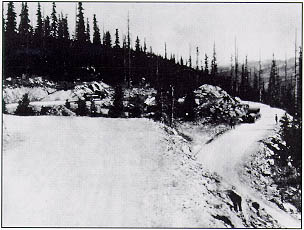
|
| 1958 | BPR establishes a Division Office in Beirut, Lebanon, to provide technical assistance in developing the highway program of that country. Little could be accomplished during the first 6 months due to an armed rebellion and period of instability. |
July 4
| 1930 | Governors of 13 States, in the area for a national Governors meeting, participate in the dedication ceremony for the $2 million Zion-Mt. Carmel Highway in Zion National Park, UT. The ceremony takes place in one of the galleries of the mile-long tunnel that is one of the unique features of the highway. The audience of 2,000 finds the tunnel delightfully cool on a sizzling Independence Day. Director of National Parks H. M. Albright introduces Chief Thomas MacDonald and District Engineer B. J. Finch, who describes some of the facts about the highway. A contemporary account describes the highway as "a wonderful engineering accomplishment in the land of natural wonders." |
July 5
| 1892 | Senator Charles B. Manderson of Nebraska introduces General Roy Stone's proposal for a National Highway Commission. (See July 17, 1892.) Representative Philip S. Post of Illinois had introduced the same measure in the House on June 29. The measure passed the Senate July 27, but failed in the House. |
| 1959 | Three BPR engineers (H. A. Radzikowski, R. S. Anderson, and S. E. Farin) complete a study tour, begun June 15, of highways in Poland. They found that good use is made of local materials while good laboratory facilities and practices were observed and highway maintenance was well performed. On the other hand, highway surfaces are not always smooth, city bypasses are congested, trees are sometimes planted on shoulders, and mechanization of highway work is limited.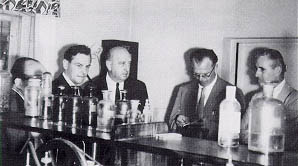
|
July 6
| 1944 | F. H. Jackson, Principal Engineer of Tests for PRA's Division of Physical Research, heads a team in California studying the causes of the disintegration of concrete structures in California, Oregon, and Washington. Defects, some of which appeared after only 3 or 4 years of service, require intensive review to ensure freedom from these troubles on future projects. The problem in California appears to be exposure to the alkali-aggregate reaction, a problem that Jackson believes can be solved by application of the principle of air entrainment. |
July 7
| 1919 | After a ceremony dedicating the temporary Zero Milestone marker on the Ellipse in Washington, DC (See June 4, 1923), the first U.S. Army transcontinental truck convoy, under Lt. Col. C. D. McClure, gets underway. It crosses the country on the Lincoln Highway, which it reaches at Gettysburg, PA, and arrives in San Francisco, CA, on September 5, with future President Dwight D. Eisenhower participating as an observer. The experience contributes to his support for the Interstate System after becoming President.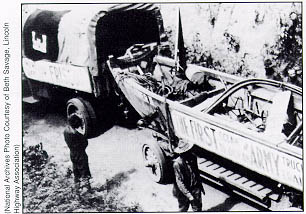
|
| 1993 | FHWA launches its 100th anniversary celebration with a gala kickoff in the USDOT Headquarters (the Nassif Building) plaza featuring distinguished guests, a courtyard full of exhibits, and an oversized commemorative "birthday card." The temperature reaches 100 degrees during the formal ceremony featuring Secretary of Transportation Federico Pea, Administrator Rodney Slater, Deputy Administrator Jane Garvey, Executive Director E. Dean Carlson, former Administrators Robert Farris, John Hassell, and Frank Turner, former Executive Director and Deputy Administrator Lester Lamm, former Executive Director R. D. Morgan, and Chairman Nick Rahall of the House Subcommittee on Surface Transportation. |
July 8
| 1912 | OPR Traveling Inspector E. W. James tells the Third Annual Convention of the Montana Good Roads Congress, "There are many men in almost every community who can tell us how to build good roads, but we have yet to find the man who can tell us how to keep any kind of road in good condition easily. This means work and the expenditure of money." |
| 1961 | The Saturday Evening Post carries an article by Arthur W. Baum on "Our New Super-Road System," discussing "where it goes, how fast it is being built, and how it will change the lives and habits of countless Americans." |
| 2009 | Gregory G. Nadeau becomes the 19th Deputy Administrator. A former member of the Maine House of Representatives (1978-1990), Nadeau served as Deputy Commissioner of the Maine Department of Transportation before taking his Federal post. |
July 9
| 1951 | In Detroit, MI, the first section of the Edsel Ford Expressway opens, financed by BPR, the State, Wayne County, and the city. The expressway is depressed below ground level, with all principal intersecting streets carried over the six expressway lanes. Frontage roads are provided at ground level for local traffic. BPR's annual report for FY 1951 says the opening "was the beginning of a new era of automobile transportation in Detroit." |
| 1964 | President Lyndon Johnson signs the Urban Mass Transportation Act to provide additional assistance for the development of comprehensive and coordinated mass transportation systems, both public and private, in metropolitan and other urban areas. The Act vests urban mass transportation functions in the Administrator of the Housing and Home Finance Agency. The authority is shifted to the Secretary of Housing and Urban Development before being transferred to the Secretary of Transportation. |
July 10
| 1919 | The first 47 of 200 government surplus war material trucks arrive in Denver, CO, most from Fort Benjamin Harrison at Indianapolis, IN. Chairman E. K. Sommers of the State Highway Commission had arranged for the shipment during a June trip to BPR in Washington, DC. At the time of the trip, J. S. Bright of BPR's Denver District Office had noted that, "There are two dumps in France, covering 9 square miles, in which you can find anything from a locomotive to a screw driver." |
| 1961 | The first of a series of "Radiological Monitoring Courses" in Region 3 is held in the North Carolina Division Office. The course is conducted by Halsey L. Mallory and D. E. Schneible. |
| 1967 | The world's leading authority on how much crash force a human being can stand, Colonel John P. Stapp of the U.S. Air Force Medical Corps, is detailed to FHWA's National Highway Safety Bureau as Chief Medical Scientist to help reduce death and injury on the Nation's highways. |
| 1916 | President Woodrow Wilson signs the Federal Aid Road Act, launching the Federal-aid highway program. The ceremony is witnessed by Members of Congress and representatives of farmers' organizations, AAA, and AASHO. Federal-aid funds are to be apportioned based on area, population, and post road mileage. The Federal share is 50 percent of the actual cost, up to $10,000 a mile. However, no funds are to be provided to a State unless it has a State highway agency and its legislature has assented to the provisions of the Act.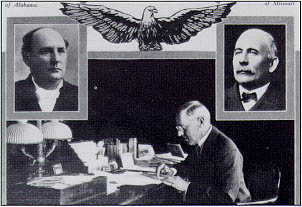
|
| 1967 | Director of Public Roads Frank Turner tells the Western Association of State Highway Officials, meeting in Honolulu, HI, to plan, design, construct, and maintain highways with an enlightened view toward their total impact on society.
"The only thing I'm sure of is that we must design, locate and build the remainder of the [Interstate] System with intensified concentration on safety, esthetics and other human values, as well as utility and efficiency. If a choice had to be made, I believe it would be better to sacrifice some small mileage than to build any remaining sections without the fullest consideration to these values. |
| 1980 | Transportation Secretary Neil Goldschmidt administers the oath of office to Administrator John S. Hassell, Jr., who had served as Deputy Administrator since August 31, 1978. Referring to the complex challenges facing FHWA, Hassell says, "I am confident that we, working in cooperation with the various State highway departments and the Congress, can and will develop solutions which will permit our highway transportation system to serve our mobility needs." |
July 12
| 1947 | By agreement with the State Department, PRA undertakes to supervise the highway program authorized by May 22 legislation to help Turkey improve its highways. The legislation authorized $5 million for purchase of highway equipment, materials, supplies, and contractual services. The Turkish Government agreed to provide adequate funds for carrying out the road program. |
| 1954 | President Dwight D. Eisenhower's "Grand Plan" for a properly articulated highway network, including the Interstate System, is unveiled at the Governors Conference, Bolton Landing, NY, by Vice President Richard Nixon (a death in the family kept the President from attending). The plan calls for a $50-billion highway program over 10 years.
"Our highway net is inadequate locally, and obsolete as a national system." |
| 1956 | AASHO adopts the initial geometric design standards for the National System of Interstate and Defense Highways (approved by BPR on July 17). Revisions are adopted April 12, 1963, October 24, 1963, December 1988, and July 1991. (See August 1, 1945.) |
July 13
| 1925 | Chief Thomas MacDonald represents BPR at the opening of the 42-mile, $390,000 Wendover Cut-Off across the Great Salt Lake Desert in western Utah, creating an entrance to Nevada and California. A contemporary account notes that the cut-off crosses "what is probably the most inhospitable waste that the vicissitudes of mother earth have produced." Construction was possible only because the Western Pacific Railroad, its line parallel to the new road, carried men and materials to construction sites. In the opening ceremony, Utah Governor George Dern, Nevada Governor J. G. Scrugham, and Secretary of Agriculture William Jardine shovel the final salt barrier from the roadway (later included in U.S. 40).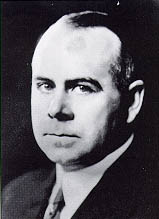
Chief, Bureau of Public Roads "I feel that the completion of this road is, first of all, a lesson in the value and wisdom of cooperative endeavor in the construction of the principal roads . . . . We may well derive, as the best result of this effort, an increased resolution to go forward to the completion of the important task of road improvement in the same spirit everywhere, until we shall have reached the goal toward which all our efforts are directed--the completion of a well balanced and thoroughly articulated system of highways for every State and for the nation as a whole." |
July 14
| 1960 | President Dwight D. Eisenhower signs the Federal-Aid Highway Act. Section 6 allows Delaware and Maryland to repay Federal-aid Interstate funds used on a portion of I-95 so the section can be built with toll financing. Because President John F. Kennedy dedicated the turnpike on November 14, 1963, 8 days before his assassination, the turnpike was renamed the John F. Kennedy Memorial Highway. Deputy Administrator Lawrence Jones represents BPR at the January 1965 second dedication ceremony. |
| 1993 | During the Great Flood of 1993, Administrator Rodney Slater visits the St. Louis area to tour flood-impacted areas along the Missouri and Mississippi Rivers. He also meets with State and local officials to discuss flood relief and FHWA's commitment to help provide all necessary assistance.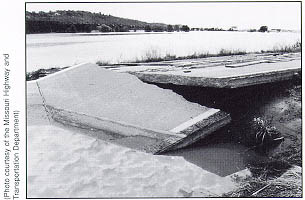
|
| 1933 | Over 4,000 people gather on Logan Pass, MT, for the opening of the Going-to-the-Sun Road after 3 decades of construction at a cost of more than $2 million. (See June 10, 1925.) In addition to speeches extolling the hard work that went into the highway, the ceremony features the Blackfeet Tribal Band playing the "Star Spangled Banner" and a chorus organized by the Civilian Conservation Corps. The afternoon ends with a ceremony of peace among the Blackfeet, Flathead, and Kootenai tribes. |
| 1957 | The 16 members of the Utah Division Office are informed their office will move from Ogden to Salt Lake City. The Ogden office was established in 1917 as a branch of OPR's District Office at Denver. On July 1, 1919, it became a District Office with jurisdiction over all Federal-aid work in Utah and Nevada and forest and park projects in Forest Service District 4. In 1945, the Ogden District Office, like all District Offices, was confined to its State borders; at the same time, each State received its own District Office. On January 7, 1957, the UT District Office, and all other District Offices, became Division Offices. The move to Salt Lake City will bring the Division Office closer to the State highway department. |
| 1992 | Director of Communications David Fredrickson introduces the first edition of the "Third Friday Report," FHWA's inhouse video magazine. In an interview, Administrator Thomas Larson attributes the idea for the show to Alcoa's Paul O'Neill, who stresses the importance of having a variety of communication channels. Also featured: the TravTek IVHS experiment in Orlando, FL, an interview with Executive Director E. Dean Carlson on career development, and FHWA 2000. (Karen Whitney hosts the magazine show beginning with the February 1993 edition.) The 41th and final edition aired in December, 1995. |
July 16
| 1913 | H. W. Hendley transfers to OPR from the Smithsonian Institution to help with photographic and model work. During the year, 70 models illustrating types of road construction are restored and 30 new road models, 3 culvert models, 1 drainage model, 1 bridge model, 1 model showing construction features in the Alps, and 1 large relief model of the Yosemite Valley of the Yosemite National Park are constructed. |
| 1963 | Ohio Division Engineer W. E. Reed and Area Engineer S. J. Kimlicko participate in the opening of the "Euclid Spur," an 8.2-mile section of I-90 east of Cleveland. The opening makes possible a drive from Cleveland to New York City, via the New York Thruway, entirely on expressway. |
| 1974 | 1974 In an interview with the Atlanta Constitution, Administrator Norbert Tiemann predicts that, "At the current level of funding, which is $2.5 billion per year, and with the 10 percent inflation rate, it will be 2007 before we'll finish the interstate highway system." |
| 1892 | The annual meeting of the League of American Wheelmen (LAW) begins in Washington, DC (through July 21). In addition to holding parades, conducting championship bicycle races, and visiting the White House, participants lobby for General Roy Stone's bill calling for a National Highway Commission to make a "general inquiry into the condition of highways in the United States, and means for their improvement, and especially the best method of securing a proper exhibit at the World's Columbian Exposition of approved appliances for road making, and of providing for public instruction in the art during the Exposition." (See May 12, 1893.) After the meeting, General Stone and former LAW president James Denn stay in Washington to continue the lobbying effort.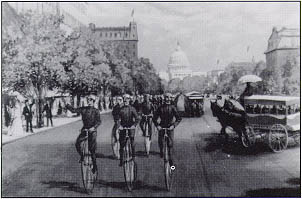
|
| 1923 | Secretary of Agriculture Henry C. Wallace recognizes completion of the 266.84-mile, 7-percent Federal-aid system in Delaware, the first State to receive this recognition under the Federal-Aid Highway Act of 1921. (See November 9, 1921.) This early completion reflects the fact that a considerable amount of the mileage had been improved before the system was designated. Under the Act, Delaware is now eligible to extend its Federal-aid system beyond the 7-percent system. |
| 2009 | Victor M. Mendez takes office as the 18th Federal Highway Administrator. He is the second Administrator, after Mary E. Peters (2001-2005), who had served as Director of the Arizona Department of Transportation. He soon launches the Every Day Counts initiative to find, foster, and promote innovation and technology in FHWA and the broader transportation community. |
| 1934 | BPR issues special provisions for construction of highways and related projects under sections of the National Industrial Recovery Act and the Hayden-Cartwright Act (June 18, 1934). The provisions cover such areas as employment lists; subletting; wages, hours of employment, and conditions of employment; and hand labor methods. In addition, all manufactured and unmanufactured articles, materials, and supplies must come from the United States, except that with respect to asphaltic materials, "it is impracticable to apply the above requirements." |
| 1962 | Administrator Rex Whitton sends a message to all BPR employees on "Will it Promote Economic Growth?" He notes that Secretary of Commerce Luther Hodges has called promotion of economic growth the Commerce Department's most important single problem.
"I urge each of you to identify yourself with the objective of increasing our economic growth, to understand how your work contributes toward this goal, and to strive constantly to seek ways and means of improving productivity in your own niche, in all areas where you have responsibility, and wherever else you see the opportunity." |
| 1973 | The Nebraska Department of Roads is the first State to have an approved State Highway Action Plan, meeting a new FHWA requirement designed to describe the procedures the State will use to ensure consideration of environmental values in developing highway projects. Administrator Norbert Tiemann, a former Governor of Nebraska, presents a plaque to Nebraska Director Thomas D. Doyle to mark the occasion. |
July 19
| 1943 | Canada and the United States exchange diplomatic notes formally naming the road from Dawson Creek in British Columbia to Fairbanks, AK -- the explicit termini -- the "Alaska Highway." |
| 1957 | Today is the last day for a BPR exhibition portraying the dramatic impact of highways on all segments of American life. It had been unveiled in the main lobby of the Department of Commerce on June 25. The main feature is the Interstate System, with graphic presentations of progress in its construction and the benefits it will make possible. |
| 1973 | In Kansas City, MO, Administrator Norbert Tiemann presents the first two Presidential Medals of Honor for Lifesaving to Jon Eugene Harley (saving an injured driver from drowning after his truck plunged off a bridge in Missouri) and Mrs. Lucille Widsteen (taking control of a bus on the Kansas Turnpike after the driver suffered a heart attack). |
July 20
| 1962 | Commerce Secretary Luther Hodges announces a BPR reorganization, establishing the Office of Right-of-Way and Location and the Office of Audit and Investigations. The former, to be headed by Edgar Swick, will be responsible for ensuring right-of-way is acquired properly and at fair cost. It also will handle all aspects of route location. The audit office, to be headed by former FBI agent Joseph O'Connor, will probe allegations of fraud, land speculation, collusion, and other irregularities, as well as auditing State claims for reimbursement of the Federal share of project costs. Three days later, Administrator Rex Whitton announces expansion of the Office of Research, which becomes the Office of Research and Development under Director Robert F. Baker.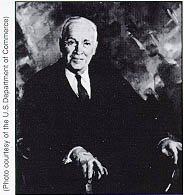
Secretary of Commerce |
July 21
| 1916 | In the first apportionment under the 1916 Federal Aid Road Act, only $5 million is available for FY 1917. Texas receives the largest amount ($291,927.81) and Delaware the smallest ($8,184.37). Under the legislation, funds increase $5 million each year, up to $25 million for 1921. |
| 1931 | BPR instructs the contractor on the first section of Skyline Drive in Virginia to proceed with work. Bids on sections A and B (19.97 miles) from Thornton's Gap to Big Meadows, VA, had been opened on June 25, 1931. Albert Brothers Contractors, Inc., of Salem, VA, was awarded the contract on June 26. Work began on July 22 and was completed on schedule on September 8, 1932. |
| 1932 | President Herbert Hoover signs the Emergency Relief and Construction Act appropriating $120 million for advances to States to match Federal-aid funds, with advances to be repaid by deduction from regular apportionment over 10 years (converted to grants by the Hayden-Cartwright Act of 1934). |
July 22
| 1909 | In West Newton, MA, OPR inspects an experimental pavement that had been built during the summer of 1908 with a binder made from a mixture of molasses, oil, and lime. The inspector finds that the road is "in a very good condition, except at a rather sharp curve where the surface had just started to pick up under traffic." |
| 1911 | OPR writes to the Iroquois Iron Works of Buffalo, NY, about the need for a 400-gallon kettle for an experimental project to resurface a road in Chevy Chase, MD, with bituminous macadam. "This section of road is traversed practically every day by the President and several members of his Cabinet, and a great many senators and representatives, as well as other persons high in official life at the Capital, and we believe will be a very good location for demonstration work." Funds are, however, limited. "We are wondering if you could make any concession on prices in consideration of the fact that this is to be a demonstration and experimental job." The letter adds, "If we were sure our appropriations will be continued through a period of years, we would buy a good outfit. If you have some good, second-hand kettles which you could rent to us, I think perhaps they might do."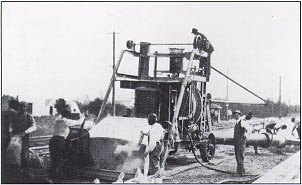
|
July 23
| 1913 | Representative William Kent of California introduces H.R. 7084, which would allow road publications issued by the States to be mailed as second class matter, with the Secretary of Agriculture deciding which documents will receive the privilege. The act, which was not approved, was intended to make it easier to spread information, but also make it easier for OPR to be a clearinghouse for the country's road building community. |
| 1975 | FHWA and the Commerce Department's Office of Minority Business Enterprise (MBE) sign a memorandum of understanding on ways to increase participation of minority business enterprises in Federal-aid construction programs. Among other things, FHWA agrees to review the feasibility of setting goals for MBE contracts and subcontracts and assist in identifying capable minority construction contractors, vendors, suppliers, equipment dealers, and service companies.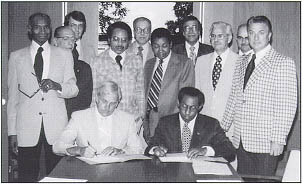
|
| 1992 | Regional Administrator David Gendell represents FHWA during the signing of a landmark agreement for integrating the NEPA and Section 404 wetlands permit processes. The consensus agreement was also signed by representatives of EPA, the Corps of Engineers, the U.S. Fish and Wildlife Service, and the National Marine Fisheries Service. The revised procedures will merge the two processes at a much earlier time than in the past, with the goal of reducing processing time.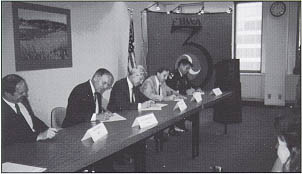
|
| 1911 | In connection with the American Association for Highway Improvement, the Touring Club of America begins a road inspection tour of Virginia to secure data as to highway conditions and especially the improvement of the notoriously bad highway between Richmond and Washington,DC, in time for the American Road Congress in November. OPR's Paul Sargent and J. E. Pennybacker, Jr., join the party, which is officially started by Vice President J. S. Sherman. (President William H. Taft agrees to attend the American Road Congress but only on condition that he not have to motor to Richmond over Virginia's roads.) |
July 25
| 1911 | OPR begins work on Mountain View Road to Sycamore, AR. The earth road, an object lesson project, is completed August 1, 1911. The total length graded was 3,000 feet, the width 16 feet, and the area 5,333 square yards. The cost to the community was $127.60. |
| 1916 | The North and South Highway Association of Idaho is organized, with Dr. L. J. Perkins of Lewiston as president, to promote a 500-mile highway connecting the northern and southern sections of the State--a goal achieved in late 1926 (U.S. 95). The idea of linking the two parts of the State captured the imagination, but financing seemed impossible until "Federal aid and distribution of forestry money . . . made possible the fulfillment of Idaho's greatest dream," as one 1926 account put it. |
| 1994 | At the White House, Jordan's King Hussein and Israel's Prime Minister Yitzhak Rabin sign a "Peace Declaration" and shake hands, ending a half century of hostilities between their countries. As part of the process leading to this day, Seppo I. Sillan, Chief of FHWA's Geometric and Roadside Design Branch, co-chaired talks about improving roads between the countries in a meeting held at the Dead Sea, Jordan, during the week before the historic "hand shake" in Washington, DC.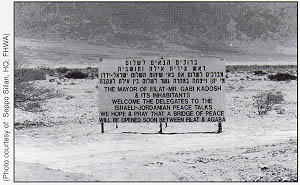
|
July 26
| 1973 | At the Holiday Inn in Bellevue, WA, Administrator Norbert Tiemann addresses the 18th Joint State Right-of-Way Seminar. He states his theme by noting that some 2,500 years ago, the philosopher Heraclitus wrote, "All is flux, nothing stays still . . . nothing endures but change." Tiemann explains that, "The old days of roadbuilding, when the main concern of the engineers was to build a highway between two points in as straight a line as possible, are gone, and they will not return." After outlining changes in the program, he concludes by quoting Henry Wadsworth Longfellow: "Look not mournfully into the past. It comes not back again. Wisely improve the present. It is thine. Go forth to meet the shadowy future, without fear, and with a manly heart."
"We must have a transportation system in which each of the modes--highways, railroads, airways, and waterways--play integral, interrelated parts. No longer can we think of the highway program as an independent endeavor; now we must always relate it to how it fits into the overall picture, how it meshes with the other transportation modes." |
| 1993 | A state-of-the-art automatic weather station is installed at FHWA's Turner-Fairbank Highway Research Center. Weather data will be used with other pavement-related data to develop improved pavement design and performance prediction models.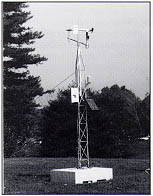
|
July 27
| 1925 | In Chicago, IL, the ICC begins a series of hearings on the complaint that motor transport is materially injuring the business of rail carriers. Representatives of rail and highway carriers, as well as shippers, testify. Chief Thomas MacDonald and J. G. McKay, Chief of BPR's Highway Economics Division, testify at length on the proposal to regulate motor carriers as the railroads are regulated. MacDonald states that motor trucks carry about 2 percent of the total volume of freight handled by the railroads. He adds that any change from rail to highway transportation was principally because the public wanted that kind of service. |
| 1986 | President Ronald Reagan signs the Commercial Motor Vehicle Safety Act, giving FHWA new tools to enhance commercial vehicle safety, including a requirement that bus and truck drivers have a single commercial driver's license based on uniform standards for testing drivers; creation of a central clearinghouse for complete driving records (See April 1, 1992); and mandatory penalties for serious traffic violations and felony convictions. |
July 28
| 1911 | Charles Hoyt, OPR's Superintendent of Construction, begins an inspection of New Hampshire's highways (through August 12) at the request of Governor Robert Bass. In Bulletin No. 42, issued February 6, 1912, Hoyt reports that "the condition of the highways was found to be much better than was expected." |
| 1924 | The contract for the last leg of the Dalles-California Highway in Deschutes National Forest, OR, is awarded to John Hampshire of Grants Pass. Completion of this project opens the last link in a highway that extends from The Dalles, OR, to the CA line. |
| 1955 | After the House turns down the proposed Federal-aid Interstate bill by a 127-to-292 vote, President Dwight D. Eisenhower issues a statement: "There is a difference of conviction, I realize, over means of financing this construction . . . . Adequate financing there must be but, and this is the important part, contention over the method of financing should not be permitted to deny our people these critically needed roads."
"The nation badly needs new highways. The good of our people, of our economy and of our defense, requires that construction of these highways be undertaken at once." |
July 29
| 1907 | At Cumberland Gap, TN, OPR begins a 12,300-foot long macadam object lesson road known as the Tri-State Road because it lies in Kentucky, Tennessee, and Virginia. The road is completed October 9, 1908. Because of the mountainous country, an unusual amount of rock excavation was required to establish a satisfactory grade. Work was suspended for 4 months during the winter, in addition to 76 days lost because of rain or other bad weather. The total cost, including excavation, macadam, and drainage, was $7,050 per mile, while the cost of the macadam alone was $0.35 per square yard, or $2,875 per mile. |
| 1946 | An Act is approved to amend the Federal Aid Road Act of 1916 by authorizing Federal dams to be constructed so as to serve as a foundation for Federal-aid highways ($10 million made available from prior authorizations for emergency reimbursement of extra costs incurred). |
| 1993 | In a ceremony on Capitol Hill, Administrator Rodney Slater unveils the Eisenhower Interstate System sign, honoring President Dwight D. Eisenhower for his role in launching the Interstate Highway Program. The sign was designed by FHWA in conjunction with AASHTO, and representatives of the Eisenhower family, the Eisenhower Center, and The Eisenhower Society. Slater says that while honoring President Eisenhower, the new sign "marks the contributions of the thousands of employees in the Federal Government, State Departments of Transportation, and industry [who] translated his vision into the world's finest highway transportation system."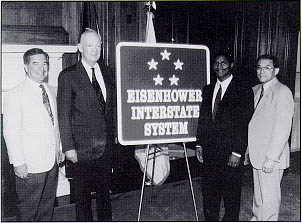
|
July 30
| 1902 | Today is the second day of the 3-day Greenville Good Roads Exposition in Michigan, sponsored by the State Highway Committee, the Montcalm County Road Makers Association, OPRI, and ARMA. Planned by Horatio S. Earle of the State Highway Committee, the exposition attracts over 25,000 people. Today, Director Martin Dodge addresses the convention on "Government Co-operation in Object-Lesson Road Work." In discussing object-lesson roads in 1900 and 1901, he says, "In all of these cases the co-operation has been very hearty on the part of the state, the county, the municipality in which the work has been done, and the results have been very satisfactory and beneficial." |
July 31
| 1945 | An Act is approved to amend the Federal Aid Road Act of 1916 to provide for payment of half the cost of acquiring and freeing toll bridges. This makes permanent the temporary powers granted during the war. |
| 1970 | For a half hour today, Miss Lynda Sue Plambeck of Carpenter, WY, is Girls Nation "Federal Highway Administrator." (Girls Nation is a youth citizenship training program conducted each year by the American Legion Auxiliary.) Sitting at the desk of Administrator Frank Turner, Miss Plambeck reviews correspondence, often asking questions about the documents before signing off on them. After she completes her duties, Turner gives her a copy of the triskelion USDOT emblem. Miss Plambeck, turning to a map of the Interstate System behind them, asks Turner, "When will you finish that road from Walcott to Carpenter?" He assures her that construction of I-80 is underway. (On October 3, 1970, when that stretch opens, FHWA is represented by Deputy Administrator Ralph R. Bartelsmeyer and former "Administrator" Plambeck.)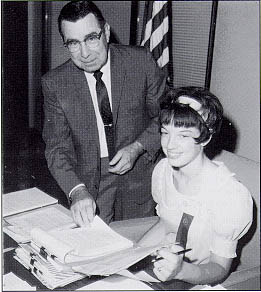
|
Also in July
| 1911 | To illustrate the tremendous impetus that lately has been given to the nationwide movement for improved highways, OPR publishes a map showing 12 proposed highways totalling 15,000 miles of transcontinental, interstate, and truck line roads. The highways, which have been proposed by individuals, associations, and communities, include the Pacific Highway on the West Coast, the Montreal-to-Miami Highway on the East Coast, an Ocean-to-Ocean Highway from Maryland to the State of Washington, as well as shorter routes such as the Du Pont Highway in Delaware and the Lincoln Way in Kentucky. |
| 1960 | Reader's Digest publishes an article titled "Our Great Big Highway Bungle," claiming that, "Haste, waste, mismanagement and outright graft are making a multibillion-dollar rathole" of the Interstate Highway Program. |
| 1961 | The Office of Research begins publication of Highway Research Newsletter, an internal newsletter to keep BPR employees abreast of interesting and new developments in highway research. |

